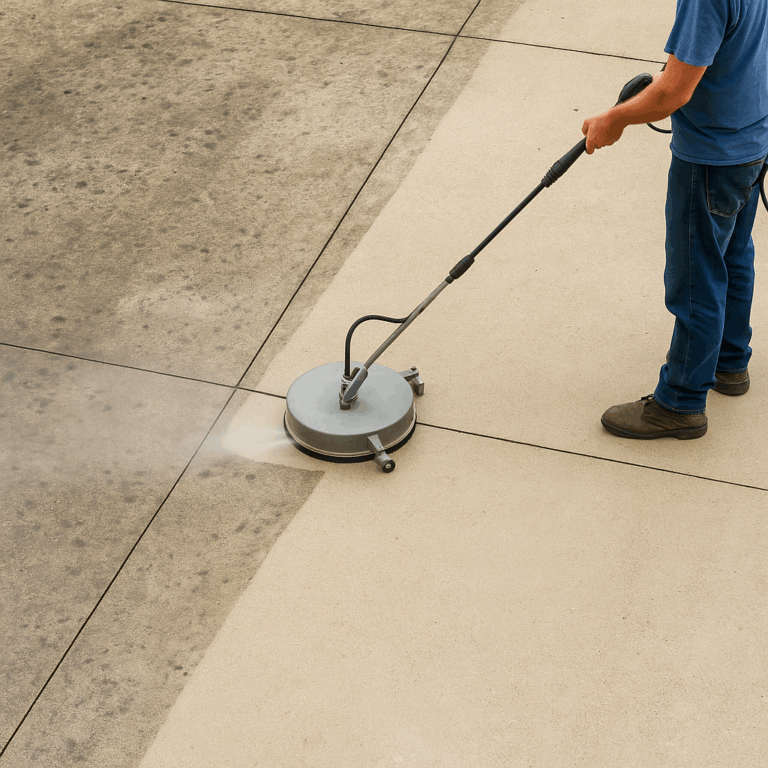Concrete is one of the most durable and widely used materials for driveways, patios, sidewalks, and garage floors. However, even this tough surface isn’t immune to time, weather, and daily wear. Over the years, dirt, oil stains, mildew, and even rust can leave your concrete looking dull and discolored. Fortunately, with the right cleaning techniques, you can bring back the brightness and extend the lifespan of your concrete surfaces.
Why Concrete Gets Dirty and Stained
Concrete is a porous material. This means it easily absorbs liquids, oils, and debris, allowing stains to penetrate below the surface. Several factors contribute to dirty or stained concrete, including:
- Oil and Grease: Common in driveways and garage floors due to cars, bikes, and machinery.
- Mold and Mildew: Thrive in damp, shaded areas, especially after rain or humidity.
- Rust Stains: Result from metal furniture, tools, or rebar oxidation beneath the surface.
- Tire Marks: Rubber residue left by hot tires can discolor concrete driveways.
- Organic Debris: Leaves, pollen, and dirt accumulate over time, causing surface discoloration.
- Efflorescence: A white powdery residue caused by water evaporating through the concrete, leaving mineral deposits behind.
Preparing for Concrete Cleaning
Before beginning any cleaning project, preparation is key. Follow these steps for the best results:
- Sweep and Rinse: Remove loose dirt, leaves, and debris using a broom or leaf blower.
- Protect Surroundings: Cover nearby plants, furniture, and doors to prevent damage from cleaning agents.
- Identify the Stains: Knowing the type of stain (oil, mold, rust) helps determine the correct cleaning solution.
- Choose the Right Equipment: Depending on the area and level of dirt, you may use a pressure washer, scrub brush, or specialized concrete cleaner.
Effective Concrete Cleaning Methods
1. Pressure Washing
Pressure washing is one of the fastest and most effective ways to clean dirty concrete. High-pressure water removes surface dirt, algae, and grime.
- Recommended Pressure: 2500–3500 PSI for outdoor concrete.
- Tip: Avoid getting too close to the surface to prevent etching. For best results, move in smooth, overlapping motions.
- Add a Cleaner: Use a concrete detergent for heavily soiled areas.
2. Using a Concrete Degreaser
For oil or grease stains, a degreaser breaks down stubborn residue.
- How to Use: Apply the degreaser directly to the stain, let it sit for 15–20 minutes, then scrub with a stiff-bristled brush.
- Rinse Thoroughly: Use warm water to lift away oil and cleaner residue.
3. Removing Mold and Mildew
Mold and mildew thrive in shaded, damp areas. To clean them:
- Mix one part bleach with four parts water.
- Spray the solution over affected areas and let it sit for 10 minutes.
- Scrub and rinse thoroughly.
- Alternatively, use an oxygen-based cleaner for a safer, eco-friendly option.
4. Rust Removal
Rust stains can be challenging, but specific cleaners make the job easier.
- Apply a rust remover formulated for concrete (often oxalic or citric acid-based).
- Let it dwell for several minutes.
- Gently scrub and rinse off.
Avoid using harsh hydrochloric acid—it can damage and discolor concrete surfaces.
5. Cleaning Paint or Sealer Residue
If your concrete has old paint, coatings, or sealants that are peeling, use a paint stripper or pressure washer to remove them. Always follow up with a deep clean to remove leftover residues before resealing.
DIY vs. Professional Concrete Cleaning
While small cleaning jobs can be managed with basic tools, larger or severely stained surfaces may require professional help.
DIY Cleaning
- Ideal for light dirt, small areas, or regular maintenance.
- Cost-effective and convenient.
- Requires proper safety gear, cleaning products, and time.
Professional Cleaning
- Best for oil-soaked driveways, commercial properties, or mold-covered patios.
- Uses commercial-grade pressure washers and eco-friendly cleaning solutions.
- Technicians can also apply sealers to protect against future staining.
Sealing After Cleaning
Once your concrete is clean and dry, applying a sealer can dramatically improve its durability and appearance.
- Benefits of sealing:
- Prevents moisture penetration.
- Reduces the risk of stains from oil, grease, and rust.
- Makes future cleaning much easier.
- Enhances surface color and shine.
Experts recommend sealing outdoor concrete every 2–3 years, depending on exposure and weather conditions.
Maintenance Tips for Cleaner Concrete
- Sweep regularly to prevent dirt buildup.
- Rinse driveways or patios monthly using a garden hose or low-pressure washer.
- Address spills immediately—especially oil or paint.
- Trim plants or shrubs that trap moisture near concrete.
- Reseal surfaces as needed for added protection.
Final Thoughts
Concrete cleaning is more than just a cosmetic fix — it’s essential for protecting your investment. Clean, well-maintained concrete not only enhances curb appeal but also reduces long-term damage caused by moisture, oil, and grime. Whether you choose to tackle it yourself or hire professionals, the key is consistency. With proper cleaning and sealing, your concrete surfaces can remain bright, safe, and beautiful for years to come.

